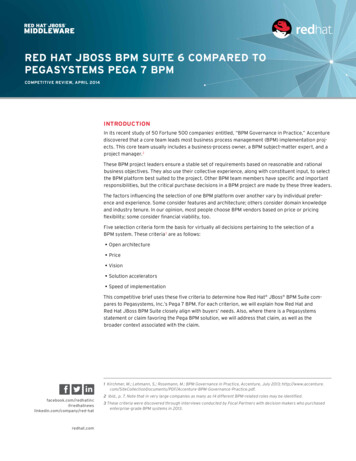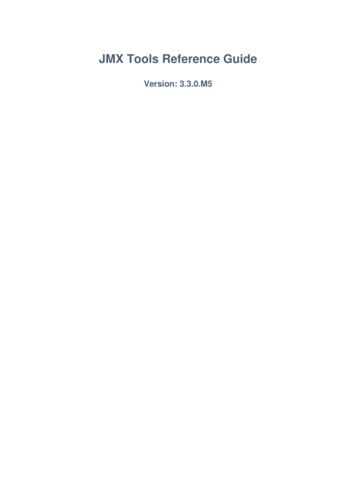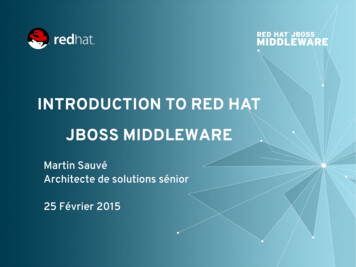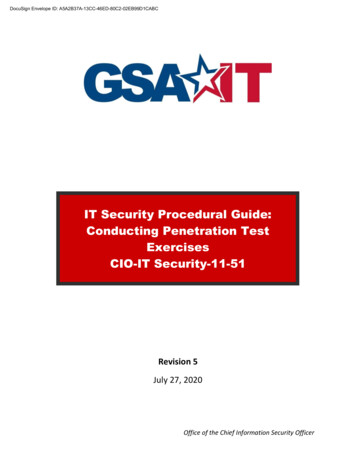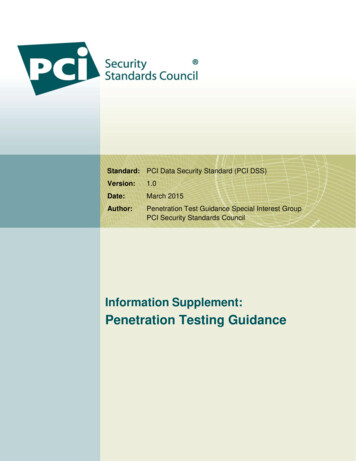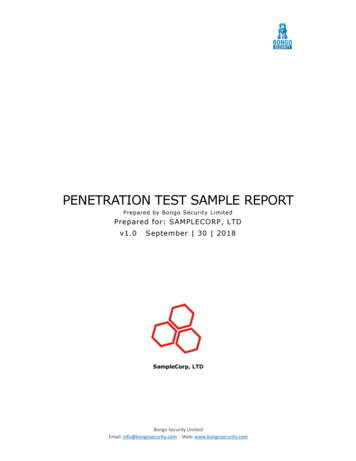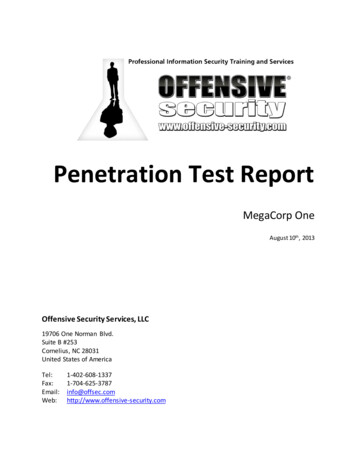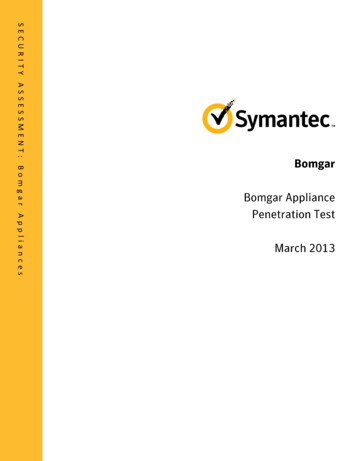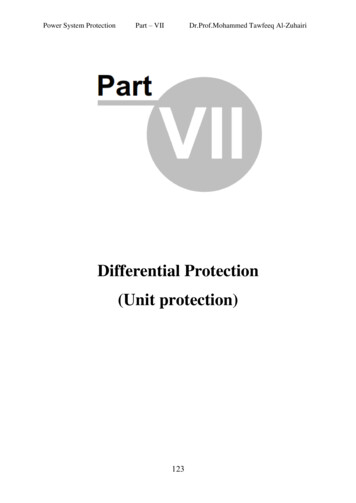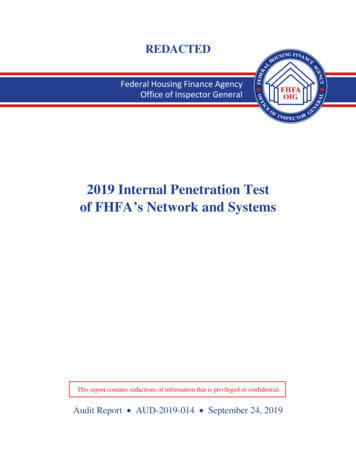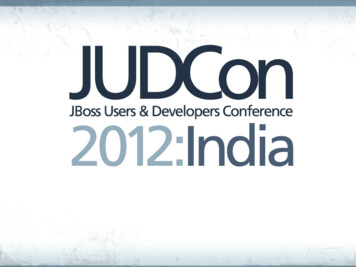
Transcription
JBoss security: penetration,protection and patchingDavid Jormdjorm@redhat.com
Contents The problem Background Historical vulnerabilities JBoss worm Security response for products The solution
The Problem
The problem JBoss is a major target, compromised JBoss serversare well documented We recently had a live worm that compromisedthousands of servers Penetration testers focus on JBoss as a potentialweak point JBoss products have coverage from SRT, JBossprojects are particularly exposed The main issues are insecure defaults and lack ofpatching/updating
Background
JBoss Projects A collection of open source projects Includes the Application Server (AS) and many othercomponents Developed by the community Released without commercial support Very widely deployed
JBoss Products Productized builds based primarily on JBoss projectcode Sold by subscription with commercial support Includes backported security patches and coveragefrom the Red Hat Security Response Team (SRT) I work for SRT, responsible for all JBoss products
JMX (Java ManagementExtensions) Framework for managing andmonitoring systems via MBeans Probe, Agent and RemoteManagement layers
JMX Console Web-based JMX management interface, shipped withJBoss AS Allows a user to invoke methods on MBeans via aweb interface Included in JBoss AS 7, EAP and derived products Password-based authentication by default on EAP,open by default on AS A major attack surface
Historical Vulnerabilities
CVE-2010-0738 The JMX console in products includes passwordauthentication by default. The relevant security-constraint tag included: http-method GET /http-method http-method POST /http-method Authentication was not applied to other verbs – e.g.HEAD The HEAD handler defaulted to the same codeexecution path as GET
CVE-2010-0738 Unauthenticated requests could be made using theHEAD verb, with the same backend effect as GET For JBoss AS, no authentication by default. Thismeans the HEAD requests also work. This is criticalas we will see when we come to the worm.
CVE-2010-4476 Double.parseDouble in the JRE can get into aninfinite loop when converting a number to a double For example, use 2.2250738585072012e-308 Can be used to effect a DoS attack Affected Java itself, but also Tomcat/JBoss Web viaHTTP headers e.g. q Fixed in Tomcat/JBoss Web by no longer usingDouble.parseDouble for the QoS header Separate fix in Java itself
CVE-2011-1484 /CVE-2011-2196 Seam did not properly restrict the use of ExpressionLanguage (EL) during exception handling. An attacker can cause the application to throw anexception, then provide a parameter including EL.The EL can include calls to .class. and .getClass(),which can be used to invoke arbitrary code. CVE-2011-1484 was fixed in April 11, but the patchwas incomplete and this was found by a user. CVE-2011-2196 shipped a complete patch in July 11. Both issues handled under embargo – no wild 0day
CVE-2011-1483 Remote DoS in jbossws-native (web services) An attacker can make a request to XML web services(e.g. SOAP) including recursive entity resolution withembedded DTDs The issue was specific to jbossws-native (JBoss), notjbossws-cxf (Apache) Enough concurrent attack requests and the serverwill consume all available connections and die Discovered by Red Hat and handled under embargo
CSRFSource: talks.php.net
CVE-2011-2908 Cross Site Request Forgery (CSRF) against JMXConsole As shipped with JBoss AS 7 Allows a remote attacker to trigger requests bytricking an admin into visiting a malicious URL This kind of flaw is often used by real world attackersand pen testers to perform 'spear phishing' attacks. Has not been patched at all, even on supportedproducts. A major outstanding flaw.
CVE-2011-3609 CSRF against AS7 management console & HTTPAPI By using plain-text JSON calls to the HTTP API,CSRF attacks can be mounted Fixed in AS 7.1.0 Beta 1 Demonstration video.
Historical Vulnerabilities –Summary There are a wide range of flaws covering a widerange of attack surfaces The vulnerabilities affect both upstream componentsand JBoss project code The JMX Console and Tomcat/JBoss Web are thesource of many issues Many lower impact flaws have also been found andfixed: XSS, information disclosure, various DoSesetc.
Historical Vulnerabilities –Summary There are a wide range of flaws covering a widerange of attack surfaces The vulnerabilities affect both upstream componentsand JBoss project code The JMX Console and Tomcat/JBoss Web are thesource of many issues Many lower impact flaws have also been found andfixed: XSS, information disclosure, various DoSesetc.
JBoss Worm
JBoss Worm Exploits CVE-2010-0738, which was patched onsupported products in April 2010 Uses HEAD verb to bypass authentication, then usesthe JMX Console to call bshdeployer and deployarbitrary code to the server Installs an IRC-based command and controlcomponent for a botnet, then runs a scanner tosearch random blocks of IP address space for moreservers to infect Also affects unsecured JBoss AS instances
JBoss Worm According to brief google research, most of theaffected systems were actually unsecured JBoss ASinstances, rather than systems vulnerable to CVE2010-0738 This highlights the core problem: if someone isrunning the latest build of AS7, they will have fixes forall issues that we have patched. If they're running anolder version, there's no backporting or asyncpatching. People running JBoss AS 5 in production arenumerous, and they're getting compromised
Security Response forProducts
Security response for products
14Embargoed vulnerabilities(50% of total, 2008-11)12108Peer vendorCoordination centreResearch firmFound by Red HatRelationship6420Embargoed JBoss Vulnerabilities
30“No notice” vulnerabilities(50% of total, 2008-11)2520CVE feedIndividual reporterSecurity mailing listOther vendorFound by Red Hat151050"No notice" JBoss Vulnerabilities
Triage Determine whether it affects our products Assign a severity (CVSS2) Prioritize according to severity Assign a CVE ID This is the fun part – reproducing bugs, runningexploits, feeling the giddy thrill of fresh 0day in yourhand
File Bugs Complex bug tracking regime: Bugzilla for the whole CVE Per-product bugs for affected products. Most inBugzilla, some in JIRA, one product now heading forEOL was even in Google Code. Task bug for monitoring SRT action
Patch Sometimes we produce the patch for our ownproducts Especially true for JBoss products with fewercontributors and people sharing the code In this case we need to commit our patch backupstream (embargoed) Other times we backport it from upstream Backporting means cherry picking security fixes
QE Patch Confirm fix solves the security issues No regressions introduced No performance degradation We've had issues with all of the above. A huge cost ifwe have to clean up one of these impacts after thepatch is released.
Errata Packages patch as either an RPM or zip file Bundles documentation of the issues Available via RHN or CSP Triggers alert emails
The Solution
The solution Secure defaults.This is already underway. AS7 has replaced the JMXconsole and applied security by default. It has alsoresolved persistent XSS and CSRF issues in themanagement -SecurityEnabledByDefault Security response for projects.This would be a whole new undertaking, with variousdependencies.
Security response for projects Vision: people no longer need to track the latestrelease to get all security fixes. Older versions aresupported with backported patches through a definedlifecycle This is similar to Fedora, so we can learn from thatproject SRT to provide inputs to this process for each flaw Optimal solution relies on bugzilla and RPMdistribution
Security response for projects:Fedora model
Security response for projects:JBoss proposal
Security response for projects Proposed tasks (in sequence)1) JBoss AS 7 gets packaged in Fedora2) Implement standard Fedora security process, withextra initial SRT assistance3) Define lifecycles for JBoss community releases4) Implement JBoss project security process, startshipping updated zips with backported patches5) Connect downstream projects, e.g. oVirt
monitoring systems via MBeans Probe, Agent and Remote Management layers. JMX Console Web-based JMX management interface, shipped with . The JMX Console and Tomcat/JBoss Web are the source of many issues Many lower impact flaws have also been found a
